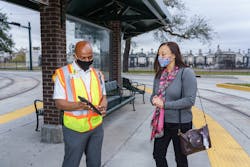New Orleans RTA Brings Operations In-House to Focus on Service Delivery and Equity
March 2021 marks the end of the first quarter of the New Orleans Regional Transit Authority (RTA) fully managing its administration and operations of the agency. For the first time in the agency’s history, all rail and bus operations are managed directly by the RTA, increasing its direct employees from 70 administrative staff to more than 800 employees in various maintenance, operations and administrative roles. With this historic change, the RTA is poised to make good on its commitment to create a world class transit system that is both equitable and reliable.
“Transit equity is the driving force behind the decision to bring RTA operations in house,” said Flozell Daniels, Jr., RTA Board chair. "We understand the importance of transit and the role it plays in the viability of families. We are excited about the intentional culturally appropriate community engagement conducted by the RTA to understand and meet our ridership needs. The RTA Board will always prioritize our riders first as we develop policies, implement service and innovate to meet the needs of our community.”
An entirely new leadership team was brought on board in 2020 and was poised to successfully take the reins of the agency and intensively focus on safety, customer service, on-time performance and equity.
Rebuilding Trust
This past year, the nation experienced a collective reckoning with the lingering impacts of institutional racism and its impacts on communities of color. More than ever, words like equity, inclusion, diversity and privilege were tossed around in every industry in the country, including transit. The RTA is no exception.
The new leadership team realized that it had to rebuild credibility and trust within the community, and quickly. Talking about equity and diversity would not be enough. New Orleans residents demanded action, transparency and results.
“While the new RTA is committed to building an equitable public transit system, we know that to be successful we must acknowledge the injustices within public transit’s history in this country and here in New Orleans,” said Wiggins. “Streetcar segregation, facilitated by ‘black star’ streetcars which were reserved for ‘colored’ passengers and the later use of screens to separate passengers, are part of that history. By understanding and acknowledging this past, we are better positioned to do the work to undo any lingering institutional damage to the people and the communities we serve - and most importantly, to make sure this dark history never repeats itself.”
In the more recent past, the prevailing sentiment of local New Orleanians is that the RTA prioritized visitors and tourists over its workforce and transit reliant families who endure long commute times from New Orleans East and the West Bank, often without the benefits of adequate shelter and comfort facilities. Sizable investments were made in streetcar expansions, which primarily serves tourists, while the RTA continues to operate skeleton bus service with only 38 percent of the pre-Hurricane Katrina bus fleet.
The trust between riders and RTA was dismal. Not dismayed, the new agency leadership understood the importance of rebuilding confidence with riders as it headed into a new era.
The New RTA
Today, the RTA has placed an intense focus on putting New Orleans residents first and is quickly making good on the promises to build a world class transit system that met the needs of all riders. To build trust and credibility with its riders and community, the RTA went to work to reduce headways from 60 minutes to 15 minutes on critical routes serving transit dependent communities, entering the agency’s two new passenger ferries into revenue service, scheduling CEO listening sessions in communities throughout the city and beginning to install bus shelters to protect riders from the weather.
Transit System Re-design
The RTA is re-envisioning transit service as the lead partner in the network redesign which aims to increase transit connectivity and equity. The New Links project, which began in 2019, is led by the New Orleans Regional Planning Commission (RPC) as a planning effort for a redesign of the greater New Orleans transit system which includes New Orleans, Jefferson and St. Bernard Parishes.
The planning team, comprised of RTA and RPC planners, placed an intentional focus on compiling rider and stakeholder feedback about the system, pain points and suggestions for improvement from a series of surveys and public forums. Surveys were conducted on board vehicles to ensure the agency received feedback from a diverse cross section of rider demographics and travel patterns.
In addition to data gleaned from rider surveys and forums, the planning team gathered ridership and operational data including a detailed study called a Comprehensive Operations Analysis (COA) of existing transit services. This includes detailed data on ridership, on-time performance and how the RTA and Jefferson Transit (JeT) use their existing bus and streetcar fleets.
“The work of the New Links project planning team to seamlessly connect RTA’s modes and transit systems across the region is imperative as we strive to meet the most basic transit needs of our riders,” said Wiggins.
From this data, the team compiled three transit re-design concepts which were presented to the community for feedback. The final network plan was presented to the RTA Board of Directors in February. This new network plan would increase the number of people living within a half mile of buses with 15- or 20-minute headways. It will improve service for residents who live in poverty and for households without cars. The system will be better coordinated across parish lines to reduce redundancy and make transfers between systems easier.
The new plan would establish transfer hubs in the West Bank, East New Orleans, St. Bernard and Jefferson Parishes, which will allow more frequent service by shortening run times on major routes to the downtown corridors. Combined, these changes will result in a measurable improvement in transit equity, reliability and overall rider experience.
With bringing transit operations and management in-house, building an experienced leadership team, focusing on the transit needs of its riders and re-designing the transit system, the New Orleans RTA is poised to lead the nation in equitable, rider-focused transit. This work is not new; it builds on the legacy of New Orleans’ early transit integration following the 1867 riots to integrate the streetcar, as well as the city’s 12-year resistance to the adoption of the Louisiana’s Separate Car Act of 1890.
New Orleans is a city built on diversity, resulting in a rich and unique culture. The RTA is proud to be a part of this community and is honored to do its part to ensure that New Orleans culture endures and prosperity is shared by all.




